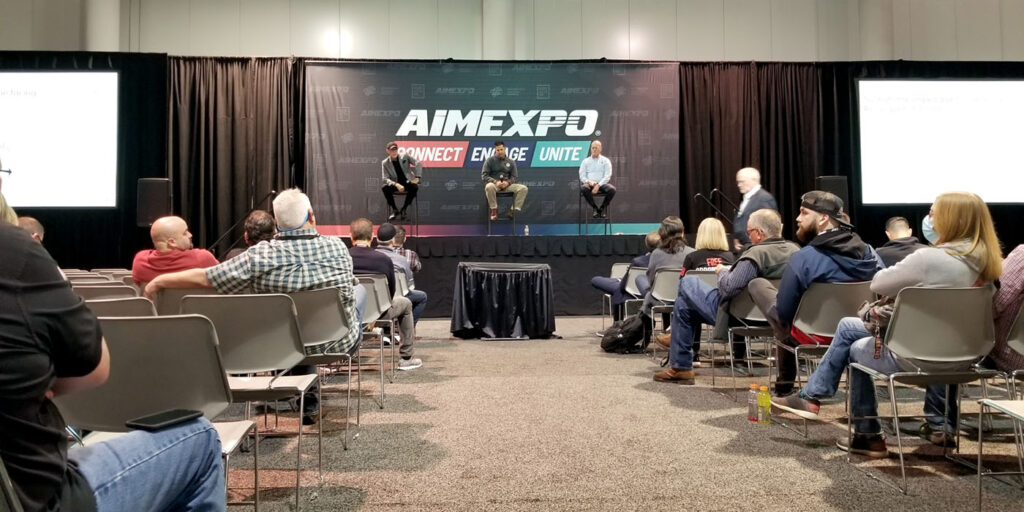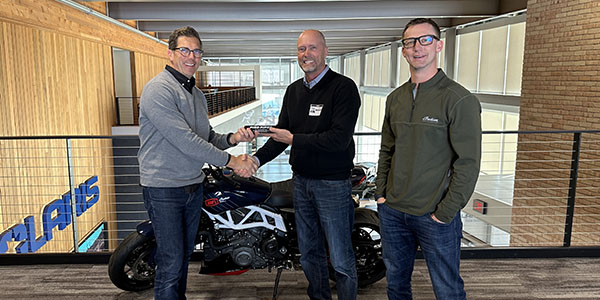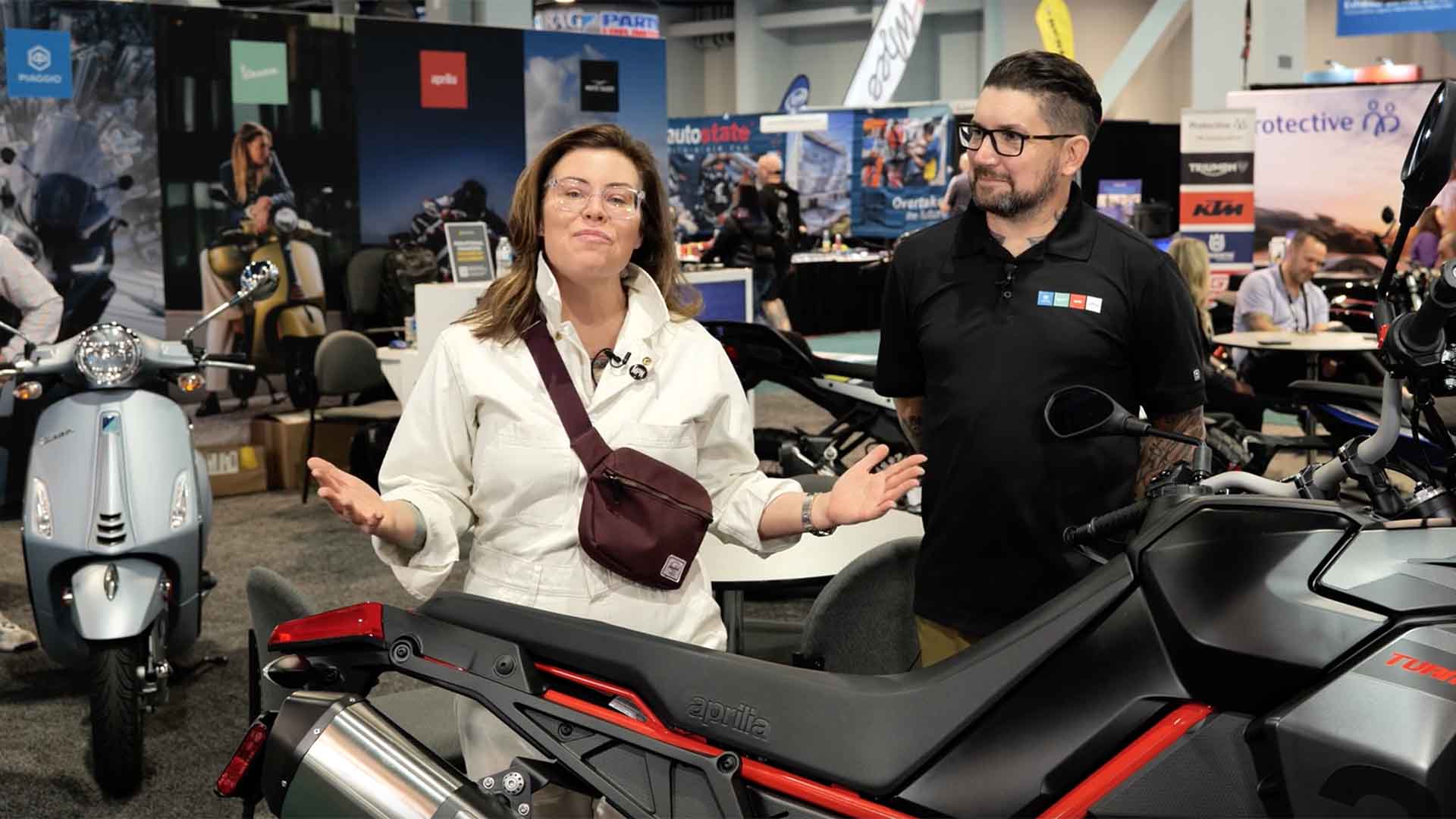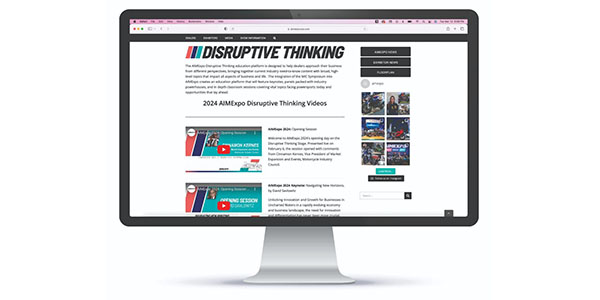This article has been updated and expanded since its initial publication on Jan. 20, 2022.
AIMExpo opened Jan. 19, 2022 in Las Vegas and hit the ground running with its educational lineup. The first session of its DISRUPTIVE THINKING educational platform was the MIC Symposium Panel Discussion, which featured industry experts Tony Gonzalez, CEO of Garage Composites; Pat Kennedy, facilitator and consultant for the Spader Group; and Gart Sutton, owner of Gart Sutton and Associates. Mark Rodgers from Rodgers Performance Consulting moderated the event.
The panel covered a variety of topics, including what the panelists thought were the single biggest issues in the motorcycle and powersports industry, how to create an employee experience to bring in more help, service department issues, the characteristics of a successful owner, signs when an owner should sell, digital retailing and more.
The Biggest Industry Issues
All the panelists agreed that inventory and supply chains issues were probably at the top of the list when it came to problems the powersports industry is currently facing. Gonzalez, in fact, did address this topic, but rather than focusing on what the problem was, he asked, “What happens when we rebound?” Inevitably, the supply chain issues will come to an end, so what happens then?
Gonzalez went on to explain how original equipment manufacturers (OEMs) need to work better with dealers in the future. To that end, dealers need to work with organizations that will influence the OEMs to take up practices that favor both groups. For instance, he said, OEMs need to stop pressuring dealers into taking on inventory that they know will only sit and collect dust.
His advice for dealers: “Don’t operate out of fear, but operate out of knowledge. This market will reflex back into something that we are more familiar with. It may go down, it may continue up. Really have your nose to the grindstone and watch your numbers and see what’s going on with your traffic logs — what’s going on with your profitability.”
Sutton saw “people” as the most important issue aside from inventory. He asked the audience, “When you find them, are you keeping them? Are you grooming them?” He went on to describe his own experience in the industry and how, when he told his boss he wanted to become a sales manager, his boss told him that he couldn’t become a sales manager without first becoming an F&I manager. In this way, Sutton had a clear path towards his career goals. As such, Sutton recommended that businesses create clear paths of career growth and make this information available to employees.
Finally, Kennedy noted that how a dealer deploys his or her people will make or break a dealership. He added that dealers have to keep a pulse on the market. “What are your tentacles like? How are you keeping your feel for the market?” he asked. He spoke of his hope that the old model of manufacturers loading up dealers with product simply for their convenience — which was not beneficial to either party — would die out after the pandemic supply chain crisis.
Creating an Experience
We all know about creating a customer experience — but what about an employee experience? “We want an experience for the employees as much as for the customer,” Sutton said. “How are they leaving your store each day? Are they happy?” Sutton noted that employees would take their cues from the owner: If the owner was happy and excited, that would naturally infect the employees as well. Of course, this experience also ties back with what he spoke about earlier when saying that dealerships need to create defined career paths.
Gonzalez noted that dealers need to keep in mind generational differences between themselves and employees. For instance, he noted, millennials need to be incentivized in different ways than baby boomers or even Gen Xers. He noted that every generation always thinks poorly of successive generations; rather than harping on it, learn to accept the differences and work with them.
Gonzalez later discussed the need for an experience in the parts and accessories department. Why? He noted that, despite vehicles flying out the store for the last 18 months, the same couldn’t be said for the parts and accessories department. “We didn’t have to do much of anything to get product out the door, [but] part and accessories have gone the opposite way.” As such, he suggested that there needs to be three to four employees in that department that will offer advice to customers, help them try on apparel and so forth.
The Service Department
“The service department is the second showroom floor,” Sutton proclaimed. And for that reason, it is important to have it running smoothly. However, there have been a few problems in that regard lately.
“How many of you have a surplus of technicians?” Sutton asked the audience. “None?” That was precisely the response he got: not a single raised hand. Of course everyone is aware of the current technician shortage, but the question remains: What can dealers do about it?
Sutton believes part of the solution lies in OEMs’ hands. He says dealers need OEMs to cultivate technicians in programs so that they get the precise experience they need for those brands and are able to go out later and work at the appropriate dealerships.
Gonzalez chimed in, adding that the service department also needs better service writers and points of contact. Always one for citing statistics, Gonzalez claimed that studies show there was over $300,000 of lost revenue in service departments in 2021 simply because customers could not get ahold of them or service departments did not follow up.
Sutton added his own hard number-advice to dealers in regards to the service department: “If you’re not at 70% margin, you’re not where you need to be.” After all, he noted, fixed operations is what keeps dealers afloat in times of crisis.
Key Characteristics of Successful Owners
“SIPD: scan, identify, predict, execute,” Sutton enunciated. According to him, this was once the acronym for dealers to live by. By having these qualities, dealers can predict the results of any problems they’re seeing. Scan your store, identify any problems, predict how they might impact business or operations and then execute a plan to fix them.
Gonzalez said it’s critical for dealers to have financial and business acumen. In addition, he believes the best dealers are the ones that continue to grow and seek out new knowledge, no matter how many years they’ve been in the industry.
Kennedy believes dealers need the discipline to execute the strategies they set. “Don’t jump on the flavor of the month,” he warned. “Don’t get sidetracked by everything that comes along. We always want the next big thing, but we can get distracted.” As such, make a plan for your business and stick to it. While you may need to be flexible at times, not all trends will be appropriate for your business model. Identify your goals and create purposeful plans to reach them.
Signs of When an Owner Should Sell
The panelists had very short and simple answers to the question: When is it time for an owner to sell?
Gonzalez said, “When the market’s hot.”
Kennedy added, “When they’re not excited anymore.”
Sutton concluded, “They’re done and their attitudes are no longer where they should be.”
Remember, employees take their tone from the dealer, so if they dealer is no longer feeling excited or pumped about the business, that will reflect in the employees’ work ethic as well.
Digital Retailing
Gonzalez said that many dealerships need a better understanding of what digital retailing is and how to utilize it.
“What we came to find was that 90% of sales of powersports equipment start online,” he said. “So that should tell you right there [that customers are starting their shopping], online whether it’s on their phone or computer or their tablet.”
However, even though most customers start the journey online, that’s not where they finish it. Gonzalez noted that 81% to 83% finish their sales in the dealership. For them, it’s a matter of doing their due diligence online and them coming into the store to look the vehicles over and ask their questions.
“Quite frankly, we feel that it is way more important to be measuring your digital front door than the actual doors right now,” Gonzalez added. However, he added that 75% to 80% of dealers don’t know where to find this info — who’s looking and at what — about their digital doors. For this reason, it’s best to work with a reputable partner that can help dealers track the customer journey from online to in-store.
Kennedy stated that digital retailing is not going away. He noted that serious dealers are as serious about what happens online as on the sales floor.
Sutton was vehement that vehicles cannot be bought online, despite what the auto industry claims, reminding dealers that customers need to see their vehicles and talk about them. It’s about establishing a rapport with the customer and creating that experience in the store that they can’t get online. Powersports vehicles are, after all, passion vehicles, not necessities, like automobiles are. Customers want to be asked where their next ride will be. They want to discuss trade-ins (and dealerships absolutely need them right now).
This was just a sample of the topics covered during the opening panel of the 2022 AIMExpo. If you’re interested in learning more about trends in the motorcycle and powersports space, be sure to keep reading industry trade publications and mark your calendars for the next iteration of AIMExpo, happening Feb. 15-17, 2023 in Las Vegas.














